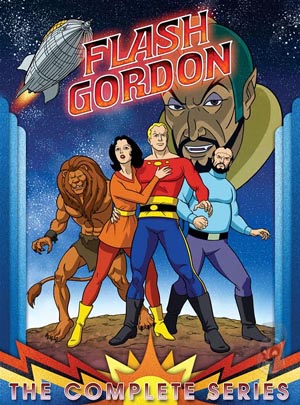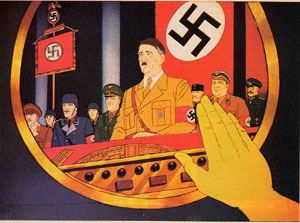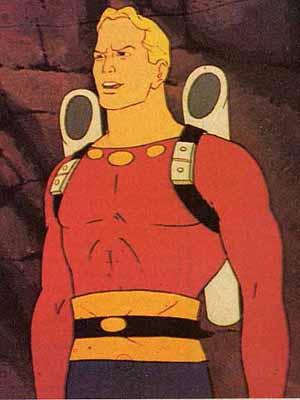Comics /
Cult Favorite
Flash Gordon: Flash in the Pan
By Philip Schweier
June 24, 2006 - 23:21
It has been announced that BCI, a subsidiary of Navarre Corporation and Hearst Entertainment, will release
Flash Gordon—The Complete Series, as a four-disc, 24 episode boxed set available July 18.
The series originally aired on NBC Saturday mornings from 1979-1981, and many who remember the series can recall the higher production standards not found in most animated shows at the time. By raising the bar of television animation, the company that produced
Flash Gordon hoped to become the dominant company for animated films for television.
In the mid-1970s, Filmation was a major contributor to Saturday morning programming, offering a wide variety of animated programs over the years. Some were based on long-time comic book and adventure characters, such as Superman and Batman. Others, such as
The Brady Kids and
Star Trek, were based on their live action counterparts, and held true to the original concept and featured the original actors providing voices.
Filmation also ventured into the arena of live action with shows of its own.
Shazam is undoubtedly the best remembered, but other efforts include
Space Academy, its spin-off
Jason of Star Command, and
Ark II.
Despite the volume of shows it produced for Saturday morning, Filmation came in second to Hanna-Barbera. Disney dominated the feature film market, and Rankin-Bass was the source for most holiday specials. It was the hope of the company that a made-for-TV animated movie could become a regular event, with Filmation at the forefront.
In the late 1970s,
Tarzan, Lord of the Jungle was highly successful, financially and creatively. It set the stage for the company’s next major project. The pulpy adventure serials of the 1930s provided the source, and the boom in science fiction brought on by
Star Wars narrowed the field.
Flash Gordon had begun as a newspaper strip by in the 1930s, beautifully illustrated by Alex Raymond. Three live-action serials starring Buster Crabbe were produced by Universal in the 1930s.
Filmation felt it had found the perfect property to help the company establish itself as a viable source of animation. Attempting to draw on the action-oriented roots in the serials, Filmation began production on a full-length animated movie. An original script was written by
Star Trek writer Samuel Peeples, who drew direct inspiration from Raymond’s original newspaper strip. The story begins in 1939, as the Nazis invade Poland. Flash, a former Olympic athlete, is working in Warsaw for the American state department. As he makes his escape with reporter Dale Arden, a meteor shower damages their plane, and they are rescued by Dr. Hans Zarkov. He explains the meteor shower is in truth an attack by the planet Mongo. Together, they journey to Mongo aboard Zarkov’s spacecraft.
There, they are captured by Emperor Ming the Merciless, and later escape with the help of Prince Thun of the Lion Men. It is revealed that Ming is providing the Nazi’s with some of their more advanced weapons, such as the V2 rocket. An uneasy alliance is established with Prince Barin of Arboria and Vultan, leader of the Hawkmen. United, the people of Mongo begin their rebellion against the evil Emperor Ming.
The movie was directed by Gwen Wetzler, and starred Robert Ridgely as Flash Gordon and Prince Barin, Diane Pershing as Dale Arden, and David Opatoshu as Zarkov. Bob Holt provided the voice of Ming the Merciless, and Ted Cassidy was featured as Prince Thun.
Before the movie could be completed, budget problems arose. Filmation needed to market the movie on existing footage, otherwise it would be unable to complete the project. Dino DeLaurentiis, a potential investor, wasn’t even aware of who Flash Gordon was until he saw Filmation’s presentation. But it evidently inspired him to enter into production on a live action film version of the character. Other filmmakers might have seen the cartoon as competition, but the forward-thinking filmmaker believed one version would only add to the publicity of the other. Filmation sold him the foreign broadcast rights to the film, but retained U.S, rights to prove itself to the American market audiences. DeLaurentiis’ investment helped Filmation meet the $2.6 million production cost, an astronomical sum for animated television in the late 1970s.
Another source of revenue was NBC. Fred Silverman, then head of programming, was a big fan of animation. His relationship with the cartoon company dated back to 1965, when the first animated program he bought for CBS was Filmation’s
Superman cartoon. Oddly, he didn’t appreciate science fiction. Nevertheless, the animated
Flash Gordon was an expensive project, and Filmation needed a commitment from somebody in order to meet its budget. When programming executives saw initial film footage, they were so impressed they asked for a weekly series.
Coming on board was writer Ted Pedersen, who had worked for Filmation on a freelance basis. He was hired to develop the series, writing 10 of the first season episodes – the remaining six being written by Peeples – but Pedersen gives credit to Flash Gordon’s original creator. “In truth Alex Raymond wrote the first season episodes. Sam and I tried to follow his storyline exactly.”
Premiering September 22, 1979,
the New Animated Adventures of Flash Gordon was a 16-chapter serial that chronicled the heroic adventures of Flash Gordon as he struggled to unite the planet’s bickering factions against the evil overlord Ming the Merciless. The action was non-stop, with space battles, the hawk city destroyed by Ming, daring escapes from the imperial palace, and the exotic alien people of Mongo. Each episode led into the next until the saga’s thrilling finale.
Despite the show's constant use of stock footage and recycled plot devices, it was groundbreaking in its animation efforts. Filmation had pioneered new techniques to be used. For instance, spaceships were rotoscoped by shooting models with a motion control camera, and then transferring the image directly to acetate.
According to Pedersen, as much of the movie animation as possible was used, though some sources claim only about 40 percent of the original film’s footage was incorporated into the series. “We could never have produced the quality of the series on a Saturday morning budget,” he says.
“Having written more than 200 animation scripts in my career,” Pedersen continues, “I consider
Flash Gordon as one of my highlights. Working on the show was a joy. Everyone else at the studio loved the project and it shows in the end result.”
But by the start of the second season, problems with the network began to arise. The serialized format of the show, requiring the episodes to be shown in sequence, made it difficult to market to syndication. A new format of 12-minute shorts featured childish storytelling coupled with lower grade animation. Alex Raymond’s epic tale was ignored in favor of corny humor. Emphasis was placed on a pink dragon named Gremlin who was introduced for comedy relief. Flash and his companions became secondary to the series, reduced to rescuing Gremlin. Each episode would end with laughter as the dragon would do something nauseatingly cute. A sad finish to a show which once had held such promise.
In March of 1980, with the first season of the show having aired, Filmation delivered the two-hour movie, entitled
Flash Gordon: The Greatest Adventure of All, to NBC. But by then there had been a change in management. Silverman had turned his programming duties over to Brandon Tartikoff, and would leave the network entirely in June of 1981. The animated Flash Gordon movie sat on a shelf for over two years, until it was finally broadcast on August 21, 1982. Sadly, the response was lackluster. Dino DeLaurentiis’ feature film, released at Christmas of 1980, had tanked at the box office due to its campy nature. The promising cartoon series had fallen victim to network decision-making and was largely forgotten. For fans of the show, the film would be a welcome addition to the DVD set, but rights for the series are separate from those of the film, and are not included in BCI's license.
Today, little remains of Filmation. The company would go on to produce fewer cartoons in the 1980s before pretty much folding entirely. Nevertheless, its
Flash Gordon series remains as an often overlooked gem in the annals of Saturday morning animation. For those of us who remember it, the show remains a bright star among the animated shows of our childhood.
“It’s nice to know folks out there have fond memories of the series,” says Pedersen. “Hopefully this DVD will introduce the real Flash Gordon to a new audience.”•
Praise & adulation? Scorn and ridicule? Email me at philip@comicbookbin.com
Last Updated: March 3, 2025 - 20:40


